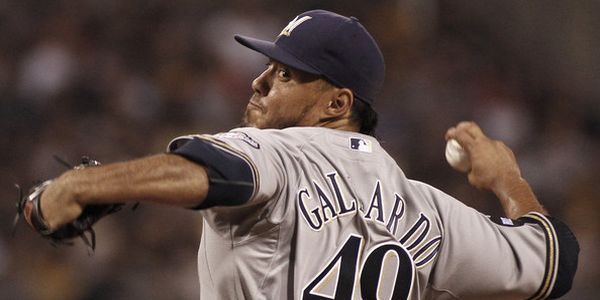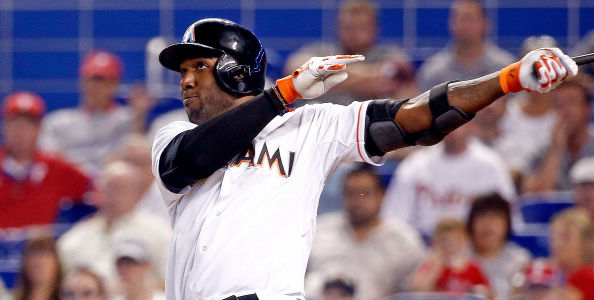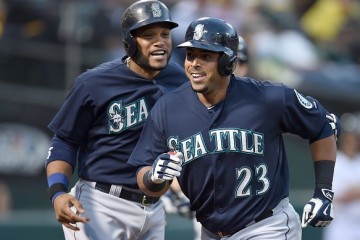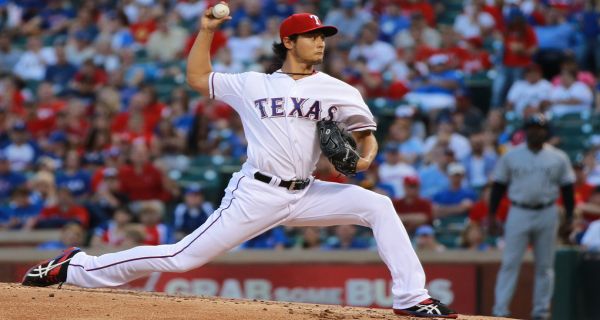2015 Fantasy Baseball: Yovani Gallardo to the Rangers


Yovani Gallardo will be leaving the only organization he’s ever played for, the Brewers, and changing leagues as a result of Monday’s trade to the Rangers. The Brewers received middle infielder Luis Sardinas, relief pitcher Corey Knebel, and 18-year old pitching prospect Marcos Diplan in return for Gallardo’s last year of team control. Knebel, assuming his damaged UCL that required him to be shutdown last year holds up, is the most likely of the trio to have fantasy value this year. He’s a flame thrower who could conceivably be in the mix to fill the closing void created by Francisco Rodriguez hitting the market as a free agent. That said, Gallardo is the focus of this piece.
His move from the Senior Circuit to the Junior Circuit is less than ideal. According to the data at Baseball-Reference, the National League league average for OPS+ was 94 each of the past two years, and the strikeout and walk rates last year were 20.92% strikeout and 7.55% walk, and in 2013 the rates were 19.95% strikeout and 7.72% walk. Comparatively, in the American League, the OPS+, strikeout rate and walk rate were 99, 19.78%, and 7.69% respectively last year, and 100, 19.76% and 8.12% in 2013. That’s what happens when one league deploys a designated hitter and the other allows pitchers to flail the bat.
The soon-to-be 29-year old starter moves from one offensively friendly home ballpark, Miller Park, to another, Globe Life Park in Arlington. While both ballparks do enhance run scoring, his new park isn’t as home run bloating. The change does little to move the needle on his fantasy value one way or the other.
Jeff Sullivan of FanGraphs took an in-depth look at one thing that could significantly hurt Gallardo’s 2015 outlook, and that’s moving from strong pitch-framing catchers, Jonathan Lucroy and Martin Maldonado, to new battery mates that might be below average framers, Robinson Chirinos and Tomas Telis. The Rangers are still reportedly looking for help at the position, so it’s possible they bring in a stronger pitch-framing catcher than they currently have on their roster, but given how highly both Lucroy and Maldonado ranked in pitch-framing by StatCorner, the addition is unlikely to be better than the duo he previously worked with. Gallardo is coming off the lowest walk rate of his career, 6.6%, a mark that was better than the league average in 2014 of 7.6%. However, Gallardo posted below league average walk rates in 2012 (9.4% compared to a league average of 8.0%) and 2013 (8.5% compared to a league average of 7.9%). He’s a nibbler that has posted below league average zone percentages for each of the last six years according to FanGraphs data, so throwing to a catcher that’s unable to net him fringe pitches like Lucroy and Maldonado are capable of could be disastrous to his walk rate.
Further cause for concern is that Gallardo may be forced to throw in the strike zone more often, and with a swinging strike rate of 6.9% each of the last two years (9.4% was the league average last year and 9.3% the year before), that’s going to mean a lot of batted balls in play. His inability to miss barrels has resulted in strikeout rates of 18.6% in 2013 and 17.9% last year. Prior to 2013, Gallardo struck out batters at a rate north of 23% annually. Looking over his PITCHf/x player card at Brooks Baseball, his whiff percentage has eroded from his best strikeout years on all of his pitches except his slider, which wasn’t a big put away pitch anyway. Last season none of his pitches generated a whiff percentage above 13%, and his best two whiff percentages came on his slider, 12.18%, and his curve, 11.73%. Perhaps Rangers pitching coach Mike Maddux can coax more bat missing out of Gallardo, but if Gallardo’s statement about preferring the easy out over the strikeout is to be believed, it would be unwise to expect an uptick in punch outs.
The lack of strikeouts hurts his fantasy value, but not all is bad with Gallardo. He does a great job of keeping the ball on the ground and induced a 50.8% groundball rate from hitters last season. He has multiple pitches capable of generating worm burners. In fact, Brooks Baseball had all but his fourseam fastball netting a groundball percentage of 50% or higher.
As a high groundball inducing pitcher, Gallardo will benefit greatly from the defensive upgrades behind him in the infield with the Rangers. The Rangers have one of the best defensive left sides of the infield in baseball with Adrian Beltre and Elvis Andrus, and the same cannot be said about the pairing of Aramis Ramirez and Jean Segura. Whether Prince Fielder returning from injury occupies first base, or Mitch Moreland does, they’re likely to look like a gold glover compared to designated hitter turned miscast first baseman, Adam Lind. And while Scooter Gennett earned higher defensive marks than Rougned Odor, Jurickson Profar could snag the keystone job from Odor this season. Profar’s defensive metrics haven’t been favorable in his limited big league time, but considering he received average to better scouting grades as a shortstop prospect, I’m willing to bet he’ll provide plus defense at the less challenging position of second base. This is all to say that his new teammates could, and probably will, help him by creating a few more outs than his old teammates would have.
Gallardo is a relatively safe bet to chew up innings since he’s made 30 or more starts for six seasons in a row, and a mid-threes ERA is achievable (3.69 ERA for his career and 3.51 last year with a 3.71 FIP for his career and 3.64 FIP last season), but he should be left undrafted in standard mixed leagues due to his inability to strike out batters at even a league average rate and his mediocre or worse production in the WHIP category. Prior to his trade Gallardo checked in as a fringe top-100 starter on my 2015 starting pitcher rankings, and that’s where he’ll remain when I revise them.





